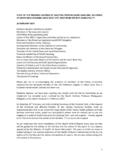Transcription of GAUTENG HEALTH DEPARTMENT DEPARTMENTAL …
1 1 GAUTENG HEALTH DEPARTMENT DEPARTMENTAL STRATEGIC PLAN Draft 2 2003-200410 December 2002 2 Part A. Strategic overview 1. Foreword by the Executive Authority 2. Foreword by the Head Of DEPARTMENT 3. Sectoral Situation Analysis Demographic profile Epidemiological profile Broad public HEALTH service structure and extent of Private HEALTH sector activity HEALTH service challenges 4. Broad policies, priorities and strategic goals The Vision The Mission DEPARTMENTAL values Legislative Mandate Strategic Goals Strategic Objectives 2003/04 priorities Part B. Budget programme and sub-programme plans 1. HEALTH Administration 2. District HEALTH Services District management/Clinics/Community HEALTH centres/Community based services /Other community services HIV/AIDS Nutrition District Hospitals 3.
2 Emergency medical services 4. Provincial hospital services General (Regional) hospitals Tuberculosis hospitals Psychiatric hospitals Chronic medical/Dental training hospitals/Other specialised services 5. Central hospital services Garankuwa Hospital Pretoria Academic Hospital Chris Hani Baragwanath hospital Johannesburg hospital 6. HEALTH Sciences and training 7. HEALTH Care Support Services 8. HEALTH facilities management Part A. Strategic overview 1. FOREWORD BY THE EXECUTIVE AUTHORITY 4 FOREWORD BY THE EXECUTIVE AUTHORITY It is my pleasure to introduce the DEPARTMENTAL three-year strategic plan for the Medium Term Expenditure Framework.
3 This plan is guided by the priorities of the National HEALTH Ministry and the Provincial Government. The plan also takes account of the inter-sectoral priority programmes, thereby ensuring that services are integrated and co-ordinated for easy access by communities and that we optimise the benefits of available public resources. HEALTH is an investment in our human resources and is conditionality for sustainable social and economic growth. Working together with other departments, the DEPARTMENT 's vision of HEALTH for a Better Life is geared towards improving the productivity and quality of the provincial human capital, and optimising the HEALTH status and life expectancy of our residents. The public HEALTH system remains the provider of the vast majority of people, with more than 9 million visits made annually to our primary HEALTH care clinics.
4 The 28 provincial hospitals run a total of 16 020 approved beds, of which 2 587 are in specialised hospitals for psychiatric care, rehabilitation or infectious diseases. Collectively, these hospitals admit 643 377 patients, with an additional million visits made to outpatient and emergency departments. Although GAUTENG has one of the highest expenditure per capita for HEALTH , the HEALTH profile of the province indicates that the greatest burden of disease remains those related to poverty and lifestyle of developing communities. This is as a result of the inherited inequity and inappropriateness of services, which were hospital biased. Our primary aim is to intercept and reduce the poverty cycle by targeting those most vulnerable to illness: historically disadvantaged communities, children, women, disabled people and the elderly.
5 We have identified various strategic objectives to tackle priority areas that would enhance the HEALTH status of the people in GAUTENG . These include: 1. Maintaining HEALTH and preventing diseases through activities such as good nutrition, immunisation programmes and HEALTH education. A major focus will be on expanding and strengthening existing programmes for maternal and child care. Examples include the Kangaroo Programme to enhance the survival of the new born babies, the Integrated Management of Childhood Diseases (IMCI) strategy, Antenatal Care services for pregnant mothers and integrated nutrition programme focusing on cr ches, primary school children at risk and children at risk for protein energy malnutrition. 2.
6 Detecting disease development early and preventing the spread of the diseases by screening those at risk for cervical and breast cancer. Support of victims of trauma and violence will receive a special focus to ensure that effective counselling and rehabilitation enable the survivors to attain optimal mental and physical rehabilitation. 3. Reducing the burden of diseases of lifestyle hypertension, diabetes through HEALTH promotion, appropriate screening and effective interventions that will enhance optimal functionality. More support will be provided at district level for the management of chronic illnesses including mental HEALTH care. Our aim is to ensure that we prevent complications such as heart attacks, strokes, blindness and other disabilities.
7 4. Consolidating programmes that will limit the impact of communicable diseases: tuberculosis, sexually transmitted disease and HIV/AIDS. Our focus areas will be to strengthen the intersectoral, inter-governmental local programmes for HIV/AIDS, the prevention of new infections, the improvement of treatment of opportunistic infections and 5home-based care. The prevention of Mother -to- Child Transmission programme will be an intervention in this MTEF. This programme will be an overall part of strengthening our maternal and child HEALTH services. The clinical and professional expertise in our HEALTH services is as important as the hospitality and support services in ensuring excellent high quality client centred care.
8 The Quality Assurance Programme, which includes setting provincial norms and standards and an Accreditation System to assess compliance, affirms our commitment to the National Patients Right Charter and the DEPARTMENTAL Service Pledge. While the patient complaints procedure is now formalised, our continued focus is to ensure that our regions and institutions have taken steps to make the complaints system more user friendly and to strengthen the hand of the consumer. The role of the Clinic Committees and Hospital Boards in the programme as well as the link with the Performance Management System will receive greater attention. The progress made with the decentralisation of authority to regions and institutions necessitates a greater focus on our monitoring and support systems.
9 This MTEF will see dedicated efforts to strengthen Primary HEALTH Care services, both at clinic, HEALTH centre and district levels. The process of devolution of the District HEALTH Services and the Transformation of Emergency Services also requires that the monitoring and support system should be extended to local government which will be playing an important role in these areas through service level agreements. Greater emphasis will be on making the services more responsive, more accountable and more appropriate to communities whilst taking full advantage of areas where we can attain benefits from economies of scale, equity and value for money. Our staff remains our most important resource. In this MTEF period, more focussed attention will be placed on workplace HEALTH and safety programs.
10 Staff retention programme will be implemented with a special emphasis on those categories with scarce skills. We will continue to provide a staff development and training program linked to our priority services as well as administrative, support and management areas. Given the budget that is linked to the DEPARTMENTAL outputs and specific targets, the strengthening of financial management systems, controls and capacity building will continue. The overall management information system will be integrated to monitor continuous progress and trends in complying with various policy and legislative requirements. There are still many challenges ahead, given the inherited poverty in our communities as well as inequity and backlogs in the available services.
















